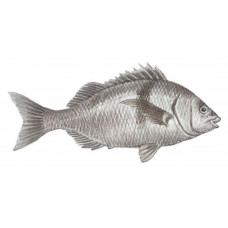Latin name
Anisotremus davidsonii
Other names
China croaker, blue bass, black croaker, grunt, xantic sargo; Spanish: burro piedrero.
Identification
The body of the adult has a compressed oval shape, the back is elevated. The head has a steep, straight upper profile and small mouth. The coloration is silvery-metallic, with a grayish tint on the back. It is silvery underneath, and a distinctive dark vertical stripe runs through the entire body from the dorsal fin to the base of the pectoral fin. At times, it can be entirely bright yellow, orange, or pure white. The young sargo, which reaches 4 inches, has several dark horizontal stripes. The vertical stripe begins to appear when the fish reaches 2-3 inches in length.
Distribution
Sargo are found in the eastern central Pacific From Magdalena Bay in Baja California, Mexico, to Santa Cruz, California.
Habitat
Sargo, inhabit coastal areas and bays on rocky and stony-sandy bottoms, often near kelp thickets, and around pilings or underwater structures. They can live in depths of up to 130 feet, most commonly found in depths of 8 to 25 feet.
Size
The maximum length of these fish can reach 22 inches.
Life history and Behavior
Swims close to the bottom in loose shoals. The fish spawns in late spring and early summer. The first spawning occurs when it reaches a length of about 7 inches and an age of 2 years.
Food and feeding habits
They are bottom feeders that mainly feed on small shrimps, crabs, clams, and snails.
Reproduction
No information
| Classification | |
| Phylum | Chordata |
| Class | Actinopterygii |
| Squad | Perciformes |
| Family | Haemulidae |
| Genus | Anisotremus |
| Species | A. davidsonii |
| Features | |
| Conservation status | Least Concern |
| Habitat | Pelagic |
| Life span, years | No information |
| Maximum body weight, kg | No information |
| Maximum length, cm | 55.88 |
| Sailing speed, m/s | No information |
| Threat to people | Edible |
| Way of eating | Bentophage |
Sargo
Tags: Sargo

